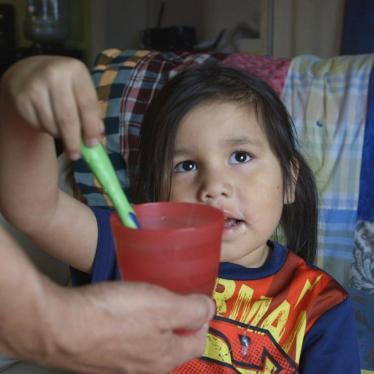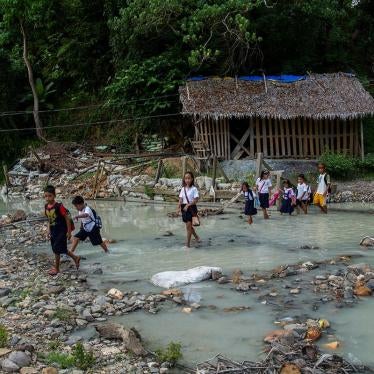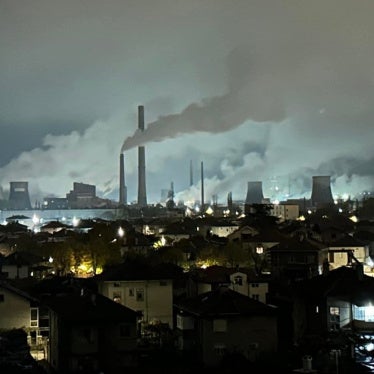Geneva, Palais des Nations, September 23, 2016
Presentation at Working Group 1: Children’s exposure to environmental toxicants
Juliane Kippenberg
Excellencies, Ladies and Gentlemen,
At Human Rights Watch, we investigate human rights violations around the world and advocate for change. In the last decade, we have documented children’s exposure to toxics in many parts of the world.
When governments fail to protect children from exposure to hazardous substances, this constitutes a violation of their rights, as spelled out in the Convention on the Rights of the Child. Children from marginalized groups—for example, from indigenous communities—are often particularly affected. According to the World Health Organization (WHO), 1.7 million children under the age of 5 died in 2012 because they lived in an unhealthy environment. Many more suffer lifelong health effects from toxic exposure.
Business activity has been the source of significant toxic exposure for children. Yet, governments often avoid regulating business to protect children from toxic exposure, because regulation can be costly and may be opposed by industries.
I want to give you an example where governments should regulate business, but often do not: the use of mercury in artisanal and small-scale gold mining. Mercury is a highly toxic metal that causes brain damage, other irreversible health effects, and even death. It is particularly harmful for the foetus and small children. Artisanal and small-scale gold mines in Africa, Asia, and Latin America use mercury to process gold and emit more than one-third of all worldwide mercury emissions.
Millions of children live or work in mining areas globally, and are exposed to mercury in the soil, water, and air because governments fail to regulate the sector. Medical studies have found that children near such mining areas often have elevated levels of mercury in their body and sometimes suffer from symptoms of mercury poisoning.
In Ghana, for instance, the vast majority of artisanal and small-scale gold mines rely on mercury. Most operate without licenses and breach environmental and child labor laws. Government authorities hardly monitor conditions in the unlicensed sites and do not promote alternatives to mercury. Health clinics do not inform people about the risks connected with mercury, let alone test or treat children for mercury poisoning. The government’s own gold trading companies buys the gold from anybody regardless of environmental standards and sells it on to international gold refiners in Switzerland, Dubai, and elsewhere.
These policies affect children’s lives and violate their rights. One of Ghana’s miners is a 12-year-old boy, Kwame, whom I met in a village in the Ashanti region of Ghana. He was working in an artisanal gold mine and one of his jobs was to process gold. For this, he mixed the mercury into the ore to create an amalgam with the gold particles, and then held it over a flame to burn off the mercury, breathing in the toxic fumes. Kwame sold the gold to a local trader, and from there, it entered the supply chain for the international gold market. Kwame showed me a small bottle of mercury that he always carried in his trouser pockets, so he could do his job.
There are many other examples where governments fail to regulate businesses that expose children to toxic chemicals. We have documented children’s exposure to toxic chemicals in leather tanneries in Bangladesh; in battery factories in China; in displaced camps in Kosovo located next to a former industrial mine; and in pesticide-sprayed tobacco farms in the United States. The communities affected by these abuses often belong to the poorest of the poor, and sometimes to minority groups, and find it hard to get heard.
But change is possible. Products have been phased out because they are harmful to children. A case in point is the phasing out of paint containing lead in some settings. Companies can also be required to account for environmental harm occurring in their supply chain. An example of supply chain regulation is the tobacco industry in Brazil. Child labor in tobacco farming exposes children to pesticides and nicotine, and is prohibited in Brazil. In order to enforce its ban, the government has established penalties that are imposed on farmers as well as companies purchasing tobacco. This has created an incentive for the tobacco industry to ensure that children are not working on farms in their supply chains.
Governments need to take comprehensive action to protect child rights in the context of toxic exposure. Business regulation is an important part of this, but not the only one. Governments need to ensure child health prevention, biomonitoring, testing, and treatment of children’s health conditions related to toxic exposure. Governments also need to inform children, parents, and the public about risks of toxic substances. And governments need to put in place systems to ensure accountability for past abuses.
In order to make this happen, governments should integrate child rights, child health, and environmental laws and policies—something that is not always happening right now.
Human rights and environmental law are largely treated as separate legal regimes with separate institutions emanating from it. On the international level, child rights concerns are largely absent from international environmental treaties. There is often a lack of coordination among United Nations agencies dealing with environmental issues and those dealing with child health and child protection. At the national level, environmental laws and policies also rarely address child rights. Government ministries for the environment do not always coordinate with ministries responsible for child protection or child health. This gap is probably one of the reasons why there is a lack of monitoring and accountability for violations of child rights that relate to the environment. This is worrying because health effects may manifest years after exposure, and because accountability can also be hampered by the lack of objective data and longitudinal studies.
A greater integration of child rights, child health, and environmental issues is possible. A step in the right direction is the 2013 Minamata Convention on Mercury, which requires treaty parties to develop strategies to prevent children’s mercury exposure in the context of artisanal gold mining, as part of national action plans. It also spells out health actions that governments need to undertake, such as testing and treating exposure, and has prompted the WHO to get more involved. A guidance by the United Nations Environment Programme (UNEP) spells out these child-specific measures for governments.
Successful litigation of past abuses is possible, too. For example, in January 2013, Thailand’s supreme administrative court ruled that the government’s Pollution Control Department had to pay compensation to 22 plaintiffs because it had failed to clean up toxic pollution from a lead processing factory that contaminated a river and poisoned nearby residents. The Supreme Administrative Court’s order to clean up the affected area was the first of its kind in Thailand, although remediation activities have yet to begin.
So much more needs to be done. Human Rights Watch believes that the Committee could and should contribute to the protection of child rights in the context of the environment by spelling out state and business obligations and providing guidance in this field. It should do so by drafting a General Comment on Child Rights and the Environment. Such a General Comment would clearly explain how the Convention obligates governments to protect children’s substantive and procedural rights in relation to the environment. It would convey the relevance of the Convention to a wide range of actors working on child rights and the environment, and help strengthen linkages between child rights and the environment.
In addition to developing a General Comment, we believe that the CRC should advise governments on how to protect child rights in the context of toxic exposure, by providing guidance on:
- Effective business regulation, including in the full supply chain;
- Child health prevention, biomonitoring, screening, testing, and treatment;
- And accountability for past violations.
Progress in each of these areas would be a real contribution to children’s rights in the age of climate change and environmental degradation.








